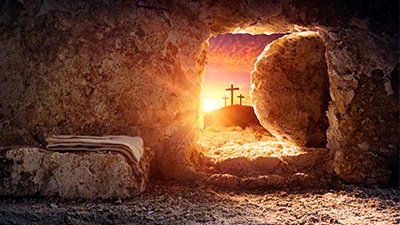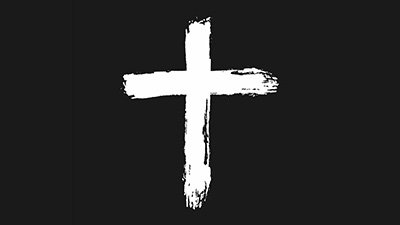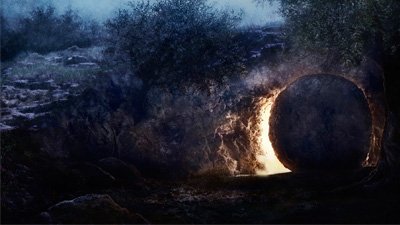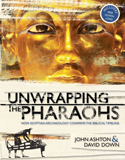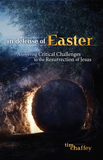![“Jesus’ tomb found” claim as empty as Jesus’ [real] tomb](https://assets.answersingenesis.org/img/cms/content/contentnode/header_image/resurrection.jpg)
“Jesus’ tomb found” claim as empty as Jesus’ [real] tomb
A review of Sunday evening’s television attack on the Resurrection
It’s the latest variation in a long line of lies that started in Matthew 28:11–15: a claim that the tomb—and ossuary (bone box)—of Jesus has been found and, along with it, the ossuaries of other members of Jesus’ family, including His mother Mary and His alleged wife, Mary Magdalene. Over 25 years ago, the bones in the boxes were removed and reburied in unmarked graves, but bone fragments remain in multiple ossuaries—including in that alleged to be Jesus’ coffin.
The implications are staggering to orthodox Christian belief, which is both built and focused on the Resurrection, divinity, and lordship of Jesus (see, in particular, 1 Corinthians 15:1–4, 12–22). If the remains of Jesus have been found (or, more precisely—as we’ll see—remains of the remains of Jesus), our faith is in vain. Thus, like the debate over origins, it is imperative that Christians closely examine and boldly answer the challenge, both to strengthen our own faith and to be ready to “give an answer” to an unbelieving world.
A close examination
Let’s now take a look at the claim, as delivered to the media in a press conference on February 26 and telecasted to the American public in a Discovery Channel TV special, The Lost Tomb of Jesus, on Sunday evening (March 4). The press conference was led and the film was directed by Canadian Jew Simcha Jacobovici, with the help of executive producer James Cameron, well-known director of such films as Titanic. (Jacobovici previously collaborated with Cameron on the 2006 film The Exodus Decoded, an exploration of the Hebraic exodus out of Egypt; Jacobovici has also coauthored a companion book to The Lost Tomb of Jesus, titled The Jesus Family Tomb.)
The claim, put simply, is that a Jerusalem tomb belonged to the family of Jesus, and that the ten ossuaries found in the tomb belonged to Jesus, Mary (mother of Jesus), Mary Magdalene (alleged wife of Jesus), Judah (alleged son of Jesus), Jose (brother of Jesus), James (brother of Jesus), Matthew (alleged relative of Jesus), and three other individuals whose names are not inscribed on the ossuaries. The tomb is known as the “Talpiot Tomb” after the southeastern Jerusalem neighborhood in which it is located.
It’s important to note that this tomb, and the ossuaries contained therein, were not recently discovered. The site was unearthed in 1980, and it, along with its contents, have been largely ignored since then, save for a 1996 BBC documentary that received little attention. The bones in the ossuaries were removed and reburied in unmarked graves, and the ossuaries themselves have been sitting in an Israeli warehouse. William Dever, professor emeritus of near east archaeology at the University of Arizona, emphasizes this: “The fact that it’s been ignored tells you something. It would be amusing if it didn’t mislead so many people.”1 Amos Kloner, a professor who led the excavation in 1980, seconds Dr. Dever: “Their movie is not serious. They [say they] are ‘discovering’ things. But they haven’t discovered anything. They haven’t found anything. Everything had already been published. And there is no basis on which to make a story out of this or to identify this as the family of Jesus.”2
Jane Root, president of the Discovery Channel, obviously disagrees: “The evidence is compelling. The consequences are enormous.”2
The film maintains an ominous tone throughout, with eerie tones underscoring the narrator’s gravely baritone. Reenactments of various scenes—Jesus teaching; Jesus on the Cross; Jesus’ burial; Jesus and Mary Magdalene—along with computer-generated 3-D visuals pepper the film, attempting to add legitimacy to controversial ideas. The film also consistently suggests the idea that the Resurrection spoken of in the New Testament was merely some sort of “spiritual ascension” of Jesus, and that it shouldn’t surprise anyone if we find His bones. Of course, this contradicts the actual account presented in the New Testament, which indicates that Christ’s body had disappeared from the tomb, and which records Christ’s reference to His post-Resurrection body as containing holes in the side and hands from the Crucifixion.
As for the names on the ossuaries, Jacobovici connects each to Jesus’ family, but the connections require various levels of faith. Keep in mind that most of these names were very common during the time of Christ; for example, the film indicates that 4% of Jews were named Jesus, and some 25% were named Mary.
Jesus, son of Joseph — Without this inscription, the Talpiot Tomb would probably have been overlooked entirely. Although the name appears convincing as Christ’s, the relative popularity of both names (Jesus, in Hebrew, being the same as Hebrew hero Joshua, and Joseph being the same as Joseph son of Jacob in the Old Testament) means this is not such an unusual combination. At least one other ossuary inscribed with “Jesus, son of Joseph” has been found3, for example.
Furthermore, Lost Tomb notes that the inscription is “informal,” “messy,” “cursory,” “graffiti,” and overall difficult to read, although it gives no indication that the inscription is anything other than “Ye[ho]shua,” the Hebrew name treated in Western languages as “Jesus.” Yet Stephen Pfann, an expert in Semitic languages, claims: “I don’t think it says Yehoshua [Jesus]. It says Hanun or something.”2 (Pfann viewed high-resolution images of the inscription.) So from the get-go, the argument that the Talpiot Tomb belongs to the family of Jesus is under fire.
Mary (mother of Jesus) — The next inscription the film tackles is “Maria,” which Jacobovici identifies as Jesus’ mother, Mary. Although this is admittedly straightforward, the fact that (as noted earlier) a quarter of Judean women at the time were named “Mary” means this is relatively inconsequential.
Matthew (alleged relative of Jesus) — One ossuary carries a form of Matthew, “Matthia,” which is not recorded as the name of anyone in Jesus’ immediate family. However, the film points out that various ancestors of Mary used variants of the name Matthew, and that it is therefore likely that Jesus may have had a close relative with a form of this name.
This unfalsifiable hypothesis highlights the nature of the whole film, which is essentially trying to prove conclusions it starts out with. Upon discovery of the Matthew ossuary, the filmmaker simply asks how it “fits in” with Jesus’ family, assuming it will somehow. By this logic, innumerable names could be said to “fit” somehow. Indeed, as the film moves along, the presuppositions of its creators—that Jesus did not rise from the dead, that the biblical record is unreliable, that Mary Magdalene and Jesus were married, etc.—are increasingly obvious.
Jose (brother of Jesus) — “Jose” is a diminutive form of the common Hebrew name “Joseph.” Because one of Jesus’ brothers is referred to by this name, Jacobovici asserts that this is a strong indication that this is the “Jesus family tomb.” Although the film states that this form of the name Joseph was uncommon, there is no definitive way to determine how “uncommon” a name was; it is easy to note that a name was common when records are filled with references to that name (such as Mary), but relatively few mentions of a name does not make it necessarily uncommon, especially if it was reserved for youths, for instance.
Mary Magdalene (alleged wife of Jesus) — At this point, the film has built up a “connection” between the first four ossuary names and the family of Jesus. It briefly interviews various individuals, asking the impact if an ossuary were to be found that “said Mary Magdalene” on it (notice the wording). In response, the various individuals all claim this would be a major indication that the tomb belonged to the family of Jesus.
Yet as the segment continues, the wording distinctly changes. Rather than an ossuary that features Mary Magdalene’s actual name, the program begins to refer to an ossuary that “could be connected to Mary Magdalene.” This subtle alteration of wording makes sense upon the viewer’s discovery that the next ossuary features the mysterious inscription “Mariamne e Mara.” Not only is the wording unusual; so is the fact that the inscription is the only one in Greek.
To set the stage for the claim that this ossuary contained the remains of Mary Magdalene, the film refers to the apocryphal “Acts of Phillip,” a fourth-century Christian text that uses the name “Mariamne” for a person some have argued is Mary Magdalene. Based on this feeble evidence from at least two hundred years after Mary Magdalene’s life, Jacobovici concludes that this ossuary contained Mary Magdalene’s remains. The “Mara,” he argues, is a term synonymous with “master” or “lord,” which makes sense, because (Jacobovici asserts) Mary Magdalene was Jesus’ “most trusted apostle.”
The connection is extremely tenuous, for it requires one to agree with one interpretation of a certain name in an apocryphal fourth-century text; and to agree that Mary Magdalene was the “most trusted apostle” of Christ, and to accept that Mary Magdalene was the wife of Jesus, giving her right to be buried with him. Naturally, all these ideas are palatable to Jacobovici. To back up his ideas, he turns to DNA testing and collects bone fragments from the Jesus and Mariamne ossuaries.
In the media over the last week, the relation between the DNA in the “Mariamne” ossuary and the “Jesus” ossuary has been consistently misconstrued, even by Jacobovici. For example, a Washington University (in St. Louis) news release adapted into a ScienceDaily article states that they [Mariamne and Jesus] were not related. A National Geographic News article reported that “[r]esults showed that the two were not related by blood” and included Jacobovici’s erroneous comment that “[t]he forensic archaeologist concluded that they were husband and wife.” Contrary to these statements, the program made clear that, because no nuclear DNA could be recovered from bone fragments, all that could be determined about the relationship between Mariamne and Jesus was that they were neither siblings nor mother/son. Jacobvici seems to want to jump to the conclusion that these two were married (based on his presupposition that Mary Magdalene and Jesus were married, and that this is the Jesus family tomb), but given that this was the tomb of an extended family, it is quite reasonable that this could be some other familial relationship such as aunt/nephew, cousin, paternal grandmother / grandson. Even so, what if this “Mariamne” and this “Jesus” were married? This would still only indicate that a Mariamne and a Jesus of the first century were married, not that this was Jesus of Nazareth and Mary Magdalene.
James (brother of Jesus) — Now the film presents viewers with a mystery: the original mapping of the tomb showed ten ossuaries, but the Israel Antiquities Authority only has a record of nine. What happened to the tenth? The film conjectures that the tenth ossuary was stolen and resurfaced a few years ago as the “James, son of Joseph, brother of Jesus” ossuary. This ossuary has undergone considerable and nearly continual criticism and counter-criticism as a forgery, partial forgery, or genuine ossuary belonging to Jesus’ brother James.
The evidence that the James ossuary is actually the tenth ossuary comes from a scan of the patina (accumulated mineral debris) on the ossuary. The filmmakers assert a match between the Mariamne and James ossuaries, and quickly show slides that—they say—indicate that the James ossuary does not match the patinas on ossuaries from other tombs. The data aren’t on the screen long enough for the viewer to review, however. Furthermore, LostTombOfJesusChrist.com notes that the 1996 A Tomb with Inscribed Ossuaries in East Talpiot paper, in reviewing the site, states that the tenth ossuary had no inscription. This would seem to raise the likelihood that either the ossuary is not from the tomb or the inscription is a forgery.
Judah (alleged son of Jesus) — Finally, the film reviews the last inscribed ossuary: that of “Judah, son of Jesus.” Again, these were common names and do not suggest anything on their own about Jesus having a son, but when coupled with the filmmaker’s belief in a marriage between Mary Magdalene and Jesus and, apparently, the non-divinity of Christ, a son apparently makes sense.
The film notes that there is nothing in the Bible to indicate that Jesus didn’t father a son, and then proposes that the Bible actually does speak of Jesus’ son in the gospel of John: the “disciple whom Jesus loved.” The film indicates that the interpretation of the “disciple whom Jesus loved” being the apostle John is wrong (apparently ignoring John 21:20–25). Instead, the film attempts to validate this view by citing John 19:26–27 as not referring to the apostle John and Mary, mother of Jesus, but rather to Jesus’ son Judah and Jesus’ wife / Judah’s mother, Mary Magdalene. Thus, Jesus—in apparent redundancy—was emphasizing that Judah and Mary Magdalene should look out for one another after He died. This twist is effectively too absurd to merit significant comment, other than to say that this view does not line up with the gospel of John itself (for example, John 19:27b makes no sense according to this interpretation) and has absolutely no basis in any biblical text, any apocryphal text, or any church tradition or legend whatsoever!
A bold answer
Despite the film’s obvious bend toward a liberal interpretation of theology and expected reliance on apocryphal texts, the case it makes may easily seduce viewers not familiar with Scripture, including both non-Christians and young Christians. And we certainly don’t wish to dismiss it out of hand; the fact that ossuaries with these names were found in the same tomb is intriguing, after all; if such theories were run-of-the-mill, there wouldn’t be so much media attention on this one. But beyond dismantling the findings of Jacobovici as erroneous (for the reasons listed above), we must give a positive answer that explains why Scripture presents a true account of history.
Many of the traditional arguments given in support of the historicity of the faith apply in this situation. For example, take the classic “who would die for a lie?” argument, which asks why followers of Jesus would allow themselves to be persecuted and killed if they knew Jesus’ Resurrection was a farce. One must ask why, if the disciples knew Jesus did not rise and had themselves stolen his body, they would have gone to fatal lengths to give testimony to the opposite. Furthermore, if the tomb of Jesus’ family was in plain sight in Jerusalem, why would opponents to the early church not have paraded this fact in opposition to Christians? Beyond that, why would there be no historical record testifying to this tomb—either from the church’s opponents, who would have wished to spotlight the error on which Christianity was based, or by early Christians, who would have venerated (or, at least, respected, cared for, and recorded the location of) such a site even if it only contained the bones of Jesus’ mother, and not Jesus himself?
Ultimately, the debate over the Talpiot Tomb (and other archaeological controversies related to the Bible, the early church, and the “historical” Jesus) have remarkable similarities to the debate over creation/evolution. In each case, the debate concerns unrepeatable, historical events that were not observed by those of us living today. In each case, the scientific evidence we find cannot prove anything on its own; it can merely be interpreted based on our presuppositions. Within a naturalistic worldview, “raw” evidence such as a canyon’s depth and a river’s erosive power is combined with the presupposition of uniformitarianism; the result is an estimated age. When inserted into the formula of the biblical worldview, such raw evidence sometimes gives completely different results.
So it is with archaeology, history, anthropology, and so forth—the raw evidence is combined with the presuppositions of a worldview to generate a resulting belief. Certain beliefs are non-negotiable, because they form part of the “root level” of a worldview. Thus, a naturalist cannot, by definition, accept divine creation ex nihilo or the Resurrection of Christ. Similarly, a biblical Christian who accepts a plain reading of Scripture cannot, by definition, accept millions of years of evolution or the mortality of Christ.
And, as with the creation/evolution debate, there are compromisers. For example, included in a short segment of the documentary is a DePaul University professor who claims the Christian faith would not be undermined if this tomb was that of Jesus’ family, and that Christians should simply let science handle the physical details. “I leave what happens to bodies up to God,” he claims in clear disagreement with the doctrine of a bodily Resurrection. This attitude promotes duplicitous thinking whereby the Bible can be true on a “spiritual level” while being false on a physical level.
We are therefore faced with a choice in the realms of these debates: accept the Bible’s historical account, or try to trust fickle sciences that cannot and do not give solid answers. No one can prove, using only science that this tomb isn’t that of Jesus’ family, and no one can prove that it is. So it is with the miracles of Christ, the miracles of the Old Testament, and the creation of the universe. A Scientific American article on the tomb put it this way: “Both sides of this debate are extraordinarily difficult to prove given the paucity of historical evidence, something this controversy has in common with nearly all archaeological and historical disputes.”4
Thus, apart from God’s Word, we are left with conjecture; with His Word, we have certainty—a certainty that weathers the perpetual storms that amass against Christianity.
As for the ongoing debate, we encourage you to visit other critiques of Lost Tomb (benwitherington.blogspot.com, christiancadre.blogspot.com, bible.org, and LostTombOfJesusChrist.com) as well as visiting the film’s official pages (www.jesusfamilytomb.com and discovery.com).
Footnotes
- www.cnn.com/2007/TECH/science/02/26/jesus.sburial.ap/index.html
- news.nationalgeographic.com/news/2007/02/070228-jesus-tomb.html
- www.latimes.com/news/opinion/sunday/commentary/la-op-allen4mar04%2c0%2c5342162.story?coll=la-sunday-commentary, Alien Life.
- www.sciam.com/article.cfm?chanID=sa003&articleID=14A3C2E6-E7F2-99DF-37A9AEC98FB0702A&catID=4
Recommended Resources

Answers in Genesis is an apologetics ministry, dedicated to helping Christians defend their faith and proclaim the good news of Jesus Christ.
- Customer Service 800.778.3390
- © 2024 Answers in Genesis

